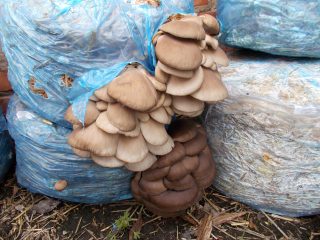Content
Autumn oyster mushroom, otherwise called late, belongs to the lamellar mushrooms of the Mycene family and the Panelus genus (Khlebtsovye). Its other names:
- late loaf;
- willow pig;
- oyster mushroom alder and green.
Appears in late autumn, when other types of edible mushrooms no longer bear fruit.
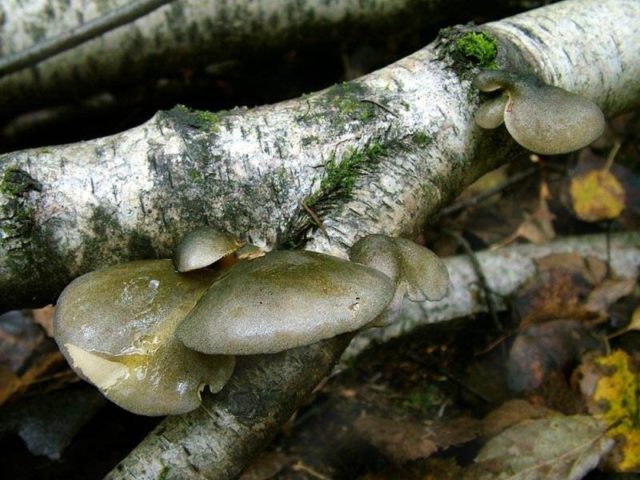
Autumn oyster mushrooms in a mixed birch-alder forest in October
Where do autumn oyster mushrooms grow
Autumn oyster mushroom is found in the northern and temperate latitudes of Russia, China, the Caucasus, Western and Eastern Europe, Ukraine, Alaska, Canada and the States. Its habitat is extremely wide.
It settles on deciduous wood: alder, aspen, birch, maple, linden, elm. Very rare in conifers. Prefers dead, standing trunks, on which it grows in large groups. Found on live trees and stumps. It can grow in close company, forming shingle-like growths, or in separate communities scattered throughout the trunk of 2-3 specimens.
Autumn oyster mushroom appears in September. Myceliums begin to bear fruit actively in October-December, because a daily temperature of +5 degrees is enough for this species to grow. Even slightly frozen fruit bodies are quite edible. They can be harvested throughout the winter, with many surviving until February and March.
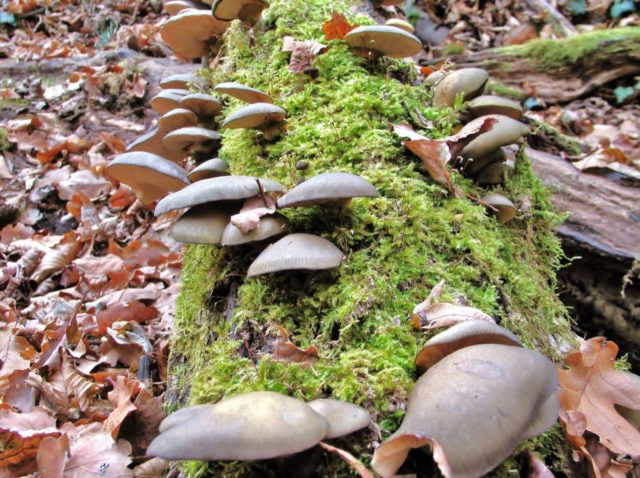
Sometimes it can take a fancy to fallen semi-rotten trunks and heaps of dead wood
What autumn oyster mushrooms look like
Autumn oyster mushroom has an ear-shaped fruiting body, it can often look like an appetizing juicy with wavy-folded edges or a petal. It grows on one side of the substrate. In young specimens, smooth edges are clearly bent inward and a semi-cone type. The mushroom then spreads out, taking a spread shape, often with an uneven, downward or broken edge.
The hat is matte, fleshy, velvety. In contact with moisture - shiny, slimy. The color can range from beige-brown to olive-golden, greenish-gray and speckled black with green. The color is uneven, the central part is lighter, almost creamy or yellowish, concentric dark and light blurred areas alternate. The width of the fungus from the substrate is from 1.5 to 8 cm, the length ranges from 2.5 to 15 cm.
The pulp is dense or loose-mealy, white-cream, yellowish. It is able to actively absorb water, so it becomes heavy, watery in the rain. In overripe fruit bodies, the consistency resembles dense rubber.
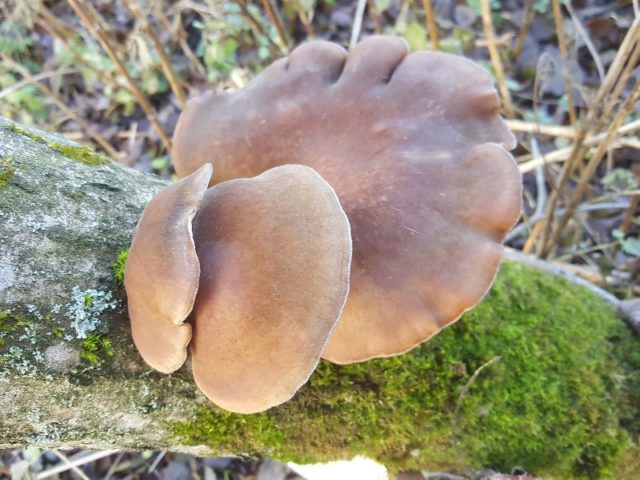
Autumn oyster mushroom can look very appetizing
The plates grow to the stem, descending. They are often located, even, thin, of various lengths. Young mushrooms are pale white or silvery, then change color to grayish, dirty yellowish and creamy brown shades. They can take ocher and bright yellow tones. Spore powder from white to lilac.
Autumn oyster mushroom has a short, strongly curved leg, significantly widening towards the cap. It is located eccentrically, from the side of the carrier tree. Dense, fleshy, without voids. The surface is smooth, slightly pubescent, with small scales. It can reach 3-4 cm in length and 0.5-3 cm in thickness. The color is uneven, noticeably darker at the cap. The colors are varied: coffee with milk, brown, light yellow, olive amber or yellowish brown. In some specimens, it may be mild.
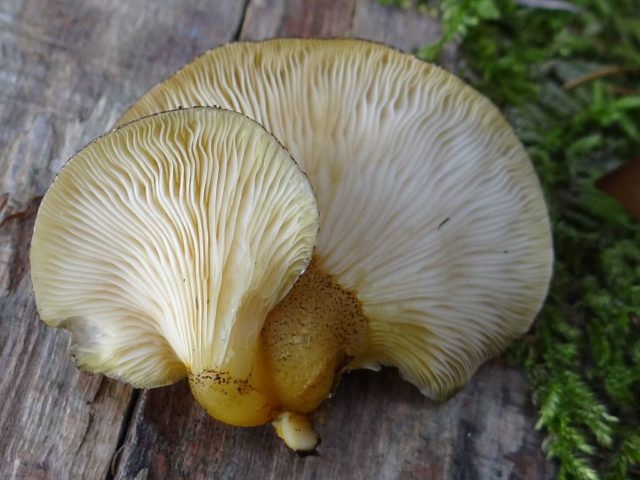
Autumn oyster mushroom often grows together with its legs, forming a single organism with several mushroom-petals
Is it possible to eat autumn oyster mushrooms
Autumn oyster mushroom is classified as conditionally edible mushroom; it should not be eaten without heat treatment. The flesh of young specimens is tender, with a pleasant fresh herbaceous aroma and a slightly bitter taste. In mature specimens, the skin resembles a slimy bog, and the pulp is tough, after frost it is distinctly bitter.
False doubles
Autumn oyster mushrooms are difficult to confuse with other mushrooms. She appears at a time when other representatives of her species are already moving away, and tinder fungi have a specific appearance. The only false poisonous twin grows in Australia.
Oyster mushroom (oyster). Edible. Has a gray-brown color, often with a purple tint, odorless pulp.
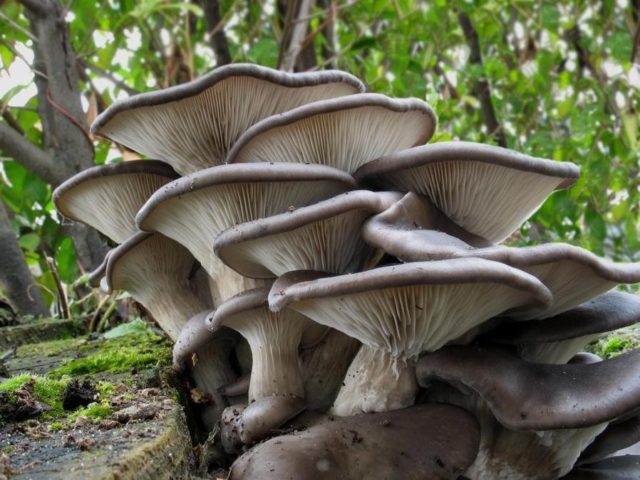
Oyster mushroom has a smooth, like a varnish, hat
Sheathed oyster mushroom. Inedible. Differs in a pronounced aroma of raw potatoes and the presence of a filmy bedspread on wide plates.
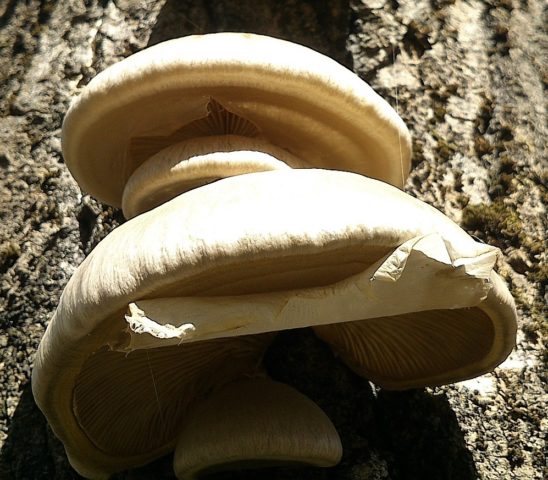
Covered oyster mushroom is easily distinguishable due to the creamy brown film and lighter color
Orange oyster mushroom. Inedible, non-toxic. It has a reddish-yellow pubescent surface and a putrid fruity odor.
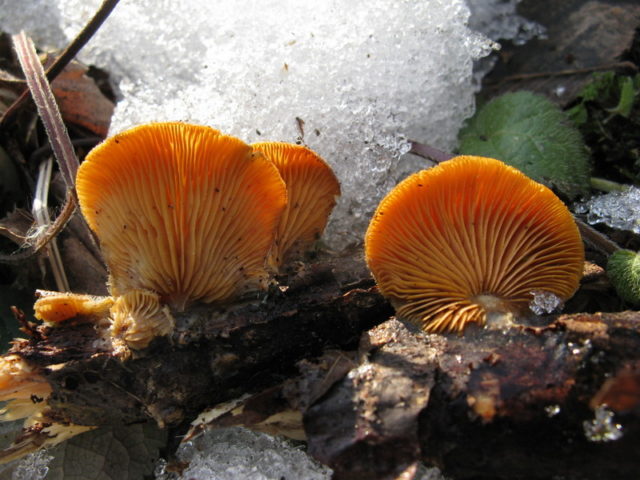
This mushroom appears in the fall and grows to resistant frosts.
Wolf saw-leaf. Inedible, contains no toxic substances. Differs in rich bitter pulp and putrid cabbage smell.
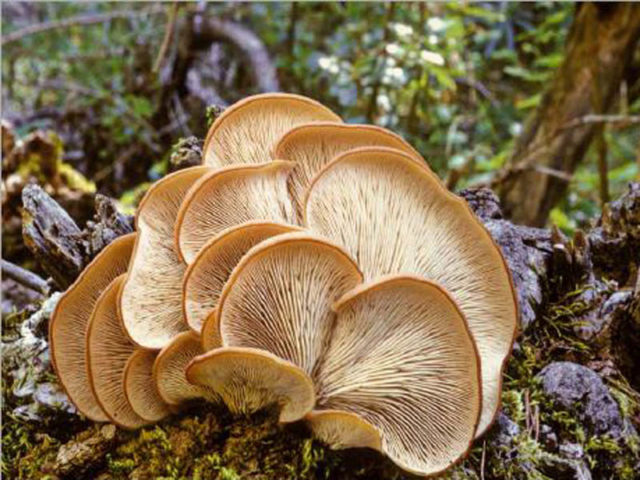
Yellow-orange-red colors are also a characteristic feature of the Sawfoot of the wolf.
Collection rules
Collect young, not overgrown specimens in dry weather. Separate the autumn oyster mushrooms from the substrate with a sharp knife, shake off the litter and cut off the near-stem part of the leg. Place the found mushrooms in a basket in even rows with plates upwards so as not to wrinkle during transportation.

Autumn oyster mushroom does not require special skills to collect it
How to cook autumn oyster mushrooms
Since autumn oyster mushroom is a conditionally edible mushroom, it can be eaten after pretreatment. Mushrooms should be cooked immediately after harvesting, they do not store for a long time even in the refrigerator. Go through, clean up from forest debris, cut off dried or darkened places. Pour over salted water, bring to a boil and cook over low heat for 15-20 minutes. Be sure to drain the broth. Rinse the mushrooms with running water. Then you can freeze them for the winter or prepare delicious meals.
Methods for preparing autumn oyster mushrooms can be different: cooking soups from fresh or dried mushrooms, frying and salting.
Fried autumn oyster mushroom with sour cream
A simple, hearty meal with affordable ingredients.
Required products:
- boiled mushrooms - 1 kg;
- sour cream - 150 ml;
- onions - 150 g;
- garlic - 2-3 cloves;
- oil or lard for frying;
- salt and pepper to taste.
Cooking method:
- Rinse vegetables, peel. Chop the onion into rings, finely chop or crush the garlic.
- Put the autumn oyster mushrooms in a hot frying pan with oil, fry until the liquid evaporates. Add onion.
- Season with salt, pepper, sour cream and garlic. Simmer on low heat, covered for 20-30 minutes.
Turn off the fire and let stand for 10-20 minutes. Sprinkle with herbs to taste.

Serve as a separate dish or with potatoes, buckwheat, pasta, rice
Autumn oyster mushroom fried in batter
Appetizing crispy mushrooms in dough are good both for a daily table and for a holiday.
Required products:
- autumn oyster mushroom caps - 1.2 kg;
- wheat flour - 75 g;
- egg - 3 pcs.;
- vegetable oil or ghee for frying - if necessary;
- salt - 15 g;
- seasonings to taste.
Cooking method:
- Salt the hats, sprinkle with spices.
- Prepare batter: mix eggs, salt, flour until smooth, creamy consistency.
- Heat the pan. Dip each hat into the dough and fry on both sides until golden brown. The oil or fat should cover the bottom of the pan at least 5-8 mm for the food to cook properly.
Put the finished oyster mushrooms in batter on a napkin to remove excess fat. You can serve it with any sauce to taste, with sour cream, herbs.
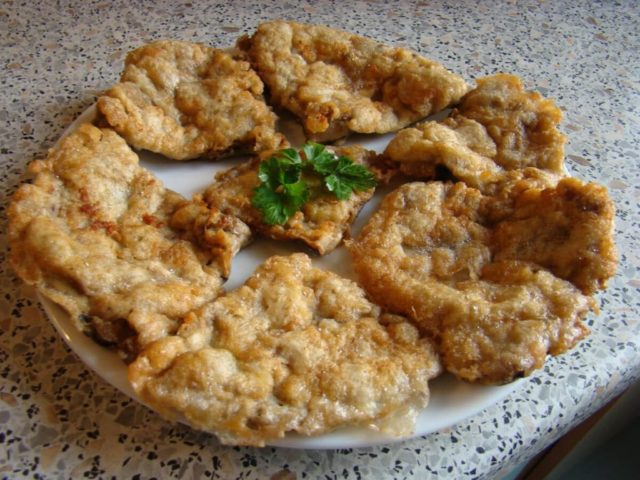
The mouth-watering dish is quite simple to prepare.
Salted oyster mushroom
One of the most popular recipes for harvesting mushrooms for the winter.
Required products:
- boiled mushrooms - 2.5 kg;
- water - 2 l;
- coarse gray salt - 90 g;
- onions - 170 g;
- garlic - 1 head;
- cherry or currant leaves - 15 pcs.;
- horseradish leaves - 15 pcs. (or dried root - 2 tbsp. l.);
- peppers - 20 pcs.;
- dill stalks with umbrellas - 8 pcs. (or seeds - 20 g);
- bay leaf - 5 pcs.
Cooking method:
- Cut large mushrooms into medium-sized pieces. Peel and rinse the vegetables, sort out the greens and leaves, cut off the black branches or dry places, wash.
- Put the mushrooms in boiling water, add salt, cook for 20 minutes.
- Put leaves, dill in sterilized jars at the bottom. Spread the mushrooms tightly so that no air bubbles remain.
- Add spices, garlic, cover with bay leaf and horseradish on top, add brine broth to completely cover the contents.
- Seal tightly with lids. After a week, the mushrooms are ready.
The preservation should be stored in a cool, dark place.
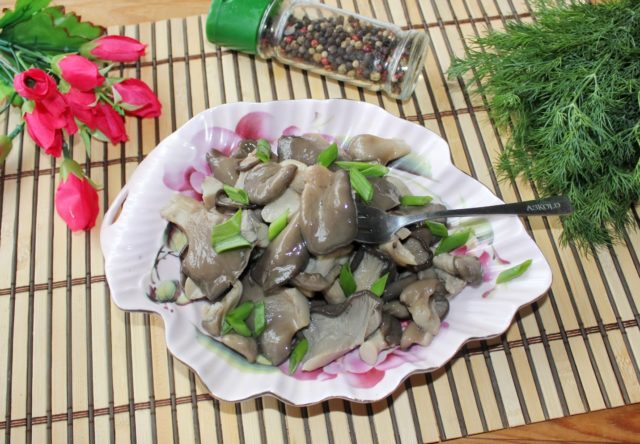
Autumn oyster mushroom with herbs and spices has an amazing aroma and rich taste
Conclusion
Autumn oyster mushroom is widespread throughout Russia and in the Northern Hemisphere. It grows on the trunks and thick branches of dead trees, processing them into nutritious humus. It settles mainly on deciduous trees. It appears in early autumn and bears fruit until December, and in the southern regions until spring. Young specimens are suitable for culinary use after pre-boiling. Dishes from these fruiting bodies should not be given to children under 6 years of age. People with gastrointestinal problems need to eat them with caution.
